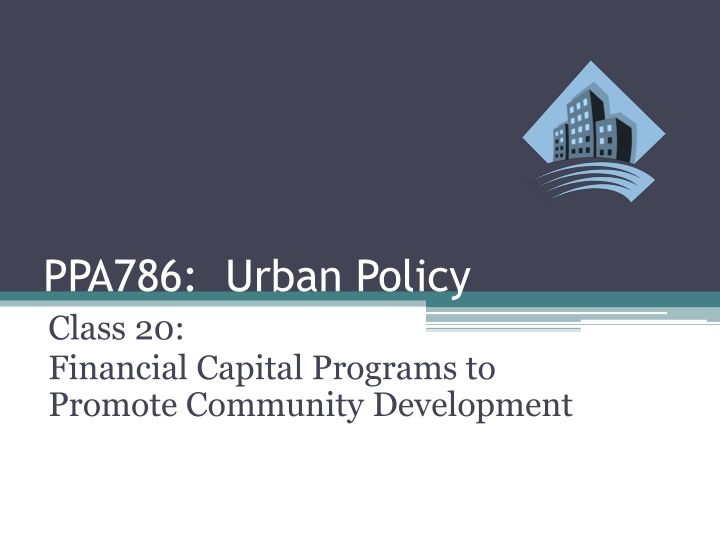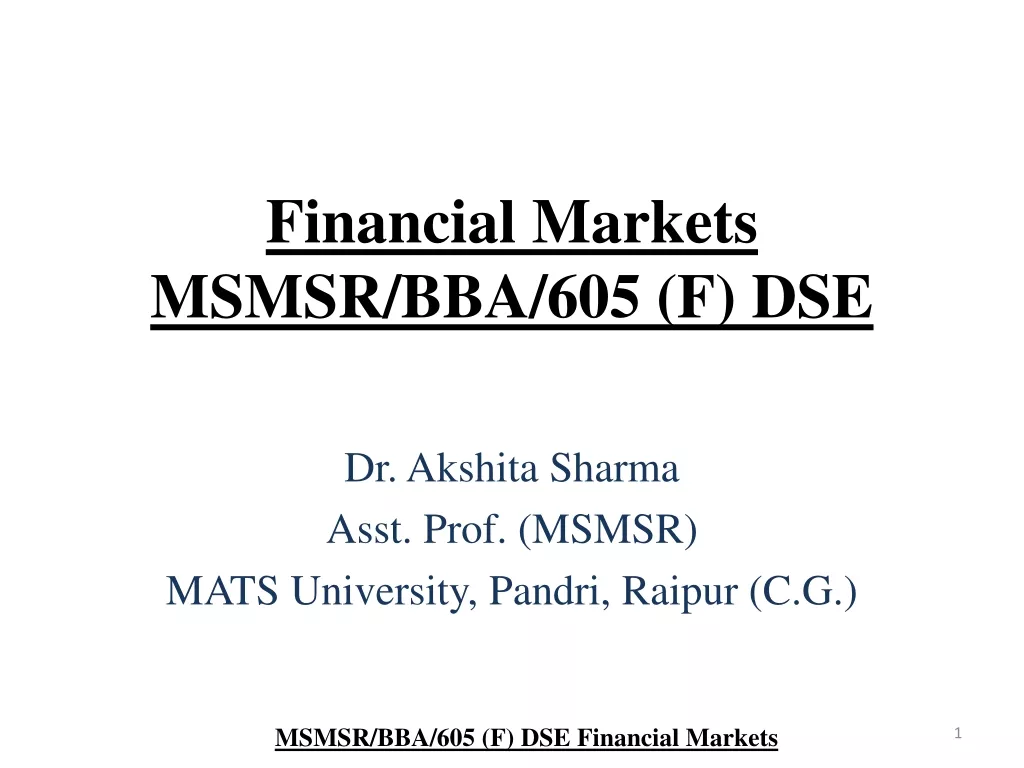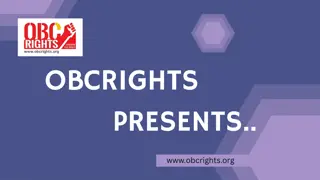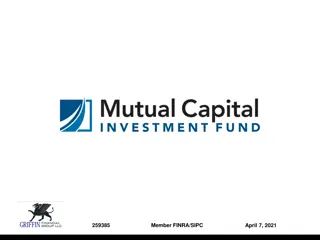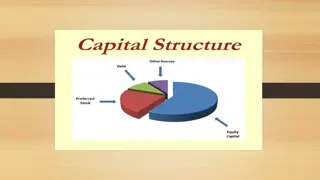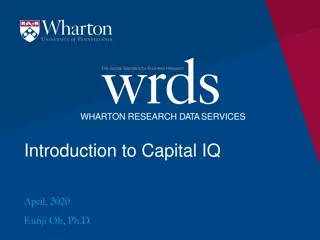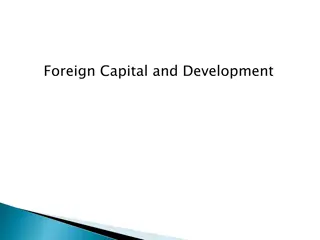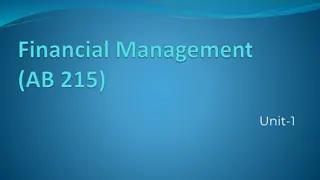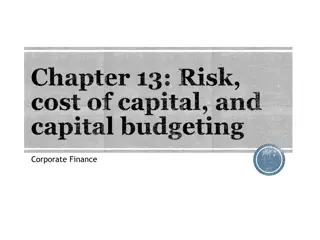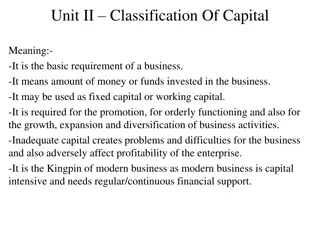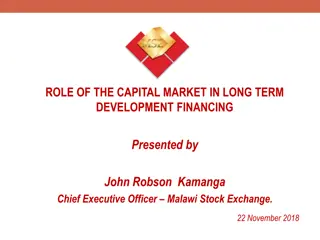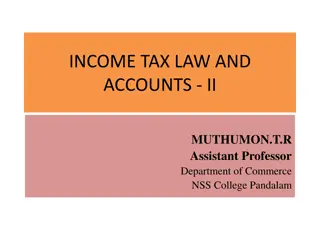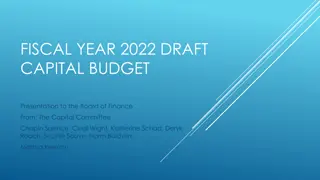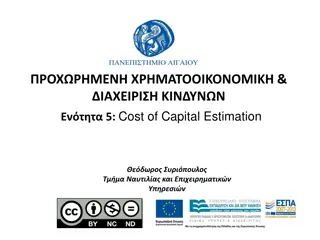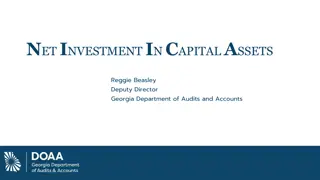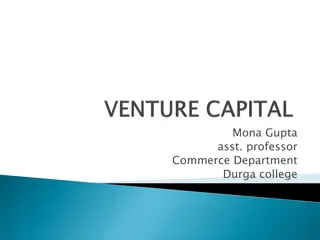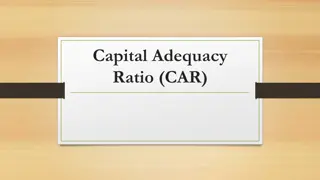Financial Capital Programs for Community Development
This Class 20 analysis focuses on financial capital programs and their role in promoting community development, particularly through Community Development Corporations (CDCs). Learn about the impact of CDCs, their current status, and the misleading emphasis on small firms in economic development efforts.
Download Presentation

Please find below an Image/Link to download the presentation.
The content on the website is provided AS IS for your information and personal use only. It may not be sold, licensed, or shared on other websites without obtaining consent from the author.If you encounter any issues during the download, it is possible that the publisher has removed the file from their server.
You are allowed to download the files provided on this website for personal or commercial use, subject to the condition that they are used lawfully. All files are the property of their respective owners.
The content on the website is provided AS IS for your information and personal use only. It may not be sold, licensed, or shared on other websites without obtaining consent from the author.
E N D
Presentation Transcript
PPA786: Urban Policy Class 20: Financial Capital Programs to Promote Community Development
PPA786, Class 20: Financial Capital Programs Class Outline Background (CDCs and Small Business) Types of Community Development Institutions Description Analysis of Impacts
PPA786, Class 20: Financial Capital Programs Background Institutional arrangements for community development and financing are very complex. Many financing programs are affiliated with a Community Development Corporation. The focus on financing activity is almost always on small business.
PPA786, Class 20: Financial Capital Programs Community Development Corporations (CDCs) CDCs are non-profit, community-based organizations that build housing, finance local businesses, and occasionally run businesses themselves. They first appeared in the 1960s and have expanded rapidly in size and numbers since. The got a big boost with the National Community Development Initiative of the 1990s, which raised hundreds of millions of dollars for CDCs from the federal government, foundations, and businesses.
PPA786, Class 20: Financial Capital Programs Current Status of CDCs There are about 4,600 CDCs, created with state, local, federal, and foundation grants. They create 86,000 units of housing per year. Advocates claim that they create 75,000 jobs per year, but there is no evidence on displacement. Only about 20% of CDCs try business development, but this number is growing.
PPA786, Class 20: Financial Capital Programs The Misleading Emphasis on Small Firms In our dynamic economy (outside a recession), many new small firms appear every year. Many fail, but some succeed and grow. Early research, now discredited, said small firms produced most new jobs. Even if small firms did produce most new jobs, there is no reason to believe that jobs could be created by subsidizing small firms in areas with few resources and little business experience.
PPA786, Class 20: Financial Capital Programs The Inevitable Focus on Small Firms Nevertheless, community development efforts will undoubtedly continue to focus on small firms. Community organizations do not have the resources to attract large firms. Community development is a place-based strategy and rarely looks into placing residents in existing large firms outside the neighborhood. This implies that training and technical assistance are almost inevitably part of any financing program for community development.
PPA786, Class 20: Financial Capital Programs Place-Based vs. Person-Based Policies We do not attempt a comprehensive comparison of place-based versus person-based strategies. But as discussed earlier, most human-capital strategies are person-based. We do not have enough evidence to understand which strategy deserves more money or which strategy works best under various circumstances.
PPA786, Class 20: Financial Capital Programs Types of Community-Level Financial Institutions Primarily for business development Community Development Financial Institutions Microfinance Primarily for consumer credit Community Development Banks and Credit Unions Savings Subsidies (Individual Development Accounts)
PPA786, Class 20: Financial Capital Programs Community Development Financial institutions, CDFIs CDFIs provide funding for low-income communities. They can take the form of community development loan funds, CDLFs; community development venture capital funds, CDVCs; community development banks; and community development credit unions.
PPA786, Class 20: Financial Capital Programs CDFIs There are over 800 CDFIs. They manage assets of over $64 billion. They heled finance over 4,100 businesses in 2012. See http://community- wealth.org/strategies/panel/cdfis/index.html
PPA786, Class 20: Financial Capital Programs Federal Support for CDFIs Since its inception in 1994, the federal government established the U.S. Department of the Treasury s CDFI Fund has awarded more than $1.7 billion to SDFIs and allocated $33 billion in New Market Tax Credits. The Treasury claims (implausibly) that CDFI program awardees created or maintained over 25,600 jobs, finance over 6.300 businesses, and provided 233,100 individuals with financial literacy training,
PPA786, Class 20: Financial Capital Programs Federal Support for CDFIs Similarly, in 2011, over $5.5 billion in loans and investments were made possible under the New Markets Tax Credit Program, with over 70% of the loans and investments made in Severely Distressed Communities. This critical financing created over 31,400 jobs and funded over $52,400 construction-related jobs; and resulted in almost 3,000 affordable housing units, 18.6 million square feet of commercial real estate, and over 8,300 businesses receiving financial counseling services. https://www.cdfifund.gov/Pages/default.aspx
PPA786, Class 20: Financial Capital Programs Evaluation of CDFIs Not much evaluation; no random assignment. These institutions are not self-supporting; they require subsidies from the federal government (through the CDFI Fund), foundations, and businesses. Benefits they may provide: training, technical assistance, investment opportunities in low- income communities, new products, new jobs.
PPA786, Class 20: Financial Capital Programs Evaluation of CDFIs: Recent Independent Reports CDFI loan fund lending fills market gaps for key underserved low-income populations; CDFI loan funds deliver between roughly two-thirds to over 90% of all loan volume to borrowers living in a CDFI Fund-designated Investment Area; From 2005 through 2012, CRA reported lending decreased while CDFI loan fund reported lending more than tripled, and during the recession this activity provided a counter-cyclical boost to the economy; CDFI loan funds provide borrowers that may not qualify for loans from mainstream sources with loan terms and interest rates that are still comparable to mainstream products; and The CDFI Fund is the second largest-source of equity to CDFI loan funds after internally-generated funds. CDFIs Stepping Into the Breach: An Impact Evaluation Summary Report
PPA786, Class 20: Financial Capital Programs Evaluation of CDFIs: Recent Independent Reports, 2 CDFI banks and credit unions were found to have no more risk of financial failure than mainstream financial institutions, even after controlling for the CDFIs degree of involvement in the mortgage market during the financial crisis; and Despite serving predominately low-income markets, CDFI banks and credit unions had virtually the same level of performance as mainstream financial institutions. Introduction to Risk and Efficiency among CDFIs: A Statistical Evaluation using Multiple Methods
PPA786, Class 20: Financial Capital Programs Job Creation by CDVCs According to Rubin (2007), a trade organization surveyed 38 companies financed in part by CDVC funds. They found that these companies had added 4,335 jobs. They also found that most new jobs went to low- income employees. But there is no analysis of displacement. For more, see www.cdvca.org
PPA786, Class 20: Financial Capital Programs Community Development Banks and Credit Unions Many low-income areas lack bank branches. Community development banks (for-profit) and credit unions (non-profit) have developed to help fill this gap. They provide consumer loans, mortgages, and business loans, as well as checking and savings accounts and, sometimes, financial education.
PPA786, Class 20: Financial Capital Programs Impacts of Community Lenders These types of lenders have appeared in many communities where lenders did not previously exist; at the very least, this makes lending services more accessible. There is anecdotal and survey evidence of benefits (see Williams 2007), but no studies based on random assignment. For more, see www.cdbanks.org
PPA786, Class 20: Financial Capital Programs Microfinance Microfinance (or microcredit) programs provide funds to small business enterprises. Microenterprise programs may also add training and counseling. There are now over 500 microenterprise, mainly microfinance, programs in the U.S.
PPA786, Class 20: Financial Capital Programs History of Microfinance Programs Microfinance started in developing countries. A loan would be given to one member of an organized group; the other group members would apply social pressure to make sure the loan was paid (and perhaps help with the payments) and offer advise and assistance until it was their turn! This approach proved to be very successful in many settings, particularly for women.
PPA786, Class 20: Financial Capital Programs Schreiner and Woller, World Development 2003
PPA786, Class 20: Financial Capital Programs Microenterprise/Microfinance in the U.S. Many microenterprise development organizations (MDOs) in the U.S. combine training and microfinance, often without the same group focus, but some just do training. Grameen America was founded in 2008 an offshoot of the bank that has been successful in developing countries. According to The New York Times, It has 18,000 borrowers and [has] lent more than $100 million. There are six Grameen branches in New York and five in other cities, including Los Angeles, Omaha and Charlotte, N.C. Most borrowers, Grameen reports, repay their debt and become repeat customers. Borrowers are also given savings accounts and encouraged to save at least $2 a week.
PPA786, Class 20: Financial Capital Programs Evaluation of Microenterprise (Schreiner & Woller) Two random-assignment studies of US microenterprise programs find small impacts. One study found that access to microenterprise programs doubled the rate of movement from unemployment to self-employment, but the absolute increase in the number people who moved was only about one per 100. Another study aimed at recipients of public assistance found that access to microenterprise programs would move, at most, about one person per 1,000 from public assistance to microenterprise.
PPA786, Class 20: Financial Capital Programs Limits to Group Lending in the United States 1. The poor don t have much social capital. 2. The poor are diverse in skills and interests. 3. It is hard to enforce joint liability. 4. Groups break down because even poor people can get loans through their credit cards.
PPA786, Class 20: Financial Capital Programs Conclusions about Microenterprise As Schreiner and Woller (2003) put it: Microenterprise is a good choice for a few extraordinary poor people, but wage jobs, additional education, and job training are still the most common paths out of poverty.
PPA786, Class 20: Financial Capital Programs Pay for Success (Tyson/Greenblatt, NY Times) In a Pay for Success contract, sometimes called a social impact bond, the government sets a specific measurable target for a program to address a particular social goal for example, reducing recidivism among juvenile offenders or providing early childhood education for vulnerable populations and attracts an investor to pay for the program. The investor does so, lured by the promise of repayment of principal if the program meets the target and a higher return if the program exceeds the target. The investor gets no payback if the program fails to deliver results. These contracts offer a win-win approach to their participants: The nonprofit secures a new source of money for a program to address a social challenge; the investor can earn a return but bears the risk; and the government pays only for success. Moreover, payment by the government is intended to come from the savings generated by the program s success.
PPA786, Class 20: Financial Capital Programs Pay for Success, 2 In fall 2011, President Obama gathered state and city officials to brainstorm about the most promising applications of the pay for success model in the US. Since then, nearly $50 million has been invested in these transactions in Massachusetts, New York and Utah, and there is rising bipartisan interest in this model across the country. At the federal level, the Obama administration proposed more than $80 million in its fiscal 2015 federal budget for these kinds of pilot programs to encourage policy innovations in juvenile justice, work force development and educational achievement. The administration has proposed a $300 million Pay for Success Incentive Fund to be housed in the Treasury Department. This fund would provide state and local governments with federal matching money for programs that produce federal budget savings. This fund would also offer a way to reduce the risk of these transactions to state and local governments, nonprofits and investors to encourage them to experiment with this approach and attract private capital for the upfront financing.
PPA786, Class 20: Financial Capital Programs Pay for Success, 3 Note that SIBs run into the same problems as public- private partnerships, namely, the need to a clear, precise contract. Public programs are not generally money-raising activities, although they may save money by preventing various kinds of costly behavior. Social impact bonds only make sense if the money saved in this way compensates the government for the payment it must make to investors. Otherwise, the government has an incentive to hold back on success so as to avoid have to pay investors,
PPA786, Class 20: Financial Capital Programs Individual Development Accounts (IDAs) An IDA is a savings account that matches payments by low-income households when the money is taken out for certain purposes, such as buying a home, starting a business, or paying for college. IDAs are surprisingly popular, with 400 programs in the U.S. (2006) with 44,000 accounts supported by governments, foundations, and corporations.
PPA786, Class 20: Financial Capital Programs The Tulsa IDA Experiment An IDA program in Tulsa matched household withdrawals for home purchase at the rate of 2:1 and withdrawals for business or education at the rate of 1:1. Up to $750 could be matched per year for 3 years, so a person could have $6,750 to buy a house. This was evaluated with a random-assignment design.
PPA786, Class 20: Financial Capital Programs Tulsa Results (Mills et al., Journal of Public Economics 2008) This team, which included a professor (Englehardt) and a graduate student from Syracuse found No significant impacts on the holdings of subsidized assets. A significant positive impact on homeownership among renters, accompanied by a significant reduction in other assets (= time-shifting of home purchase decision?)
PPA786, Class 20: Financial Capital Programs Tulsa Results, Continued Despite strong incentives, regular interaction between program staff and treatment group participants, and the presence of a strongly motivated group of savers, we find generally weak sample-wide effects of the Tulsa IDA program on household behavior. There are no sample-wide impacts on holdings of subsidized assets. The strongest subgroup effect occurs for homeownership among renters. At 7 11 percentage points, this effect is economically and statistically significant, but it is offset to some extent by a reduction in non-retirement financial assets and could be upwardly biased due to short-term time-shifting of home purchases.
PPA786, Class 20: Financial Capital Programs SEED OK Another random-assignment experiment focused on college savings for children. 529 plans are used by many states; they allow parents to accumulate returns tax fee on money invested in a college fund for their children. SEED OK added further incentives to these plans for randomly selected families in Oklahoma.
PPA786, Class 20: Financial Capital Programs SEED OK, 2 The recipients got $1,000 in a state 529, $100 if they opened their own 529, and a match for money they put into their 529. The match is 1 to 1 for households with AGI < $29,000 And 0.5 to 1 for households with AGE between $29,000 and $34,499.
PPA786, Class 20: Financial Capital Programs SEED OK, 3 An evaluation in JPAM (Nam et al. 2013) found that nearly 100 percent of the treatment group had a 529 account, compared to 2.3 percent of the control group. significant differences between the treatment and control groups in 529 account-holding rates, 529 individual savings, and total 529 assets.
